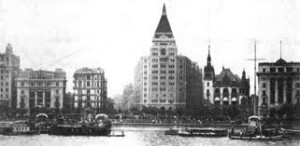Shanghai – First Impressions No.16 – Edna Lee Booker Returns, 1937
Posted: September 5th, 2013 | No Comments »New Life – Edna Lee Booker – 1937
In 1937 Edna Lee Booker arrived back in Shanghai with her young daughter Patty and her son John Jr. after a break and found a very different city.
Read Edna’s first arrival in 1922 here
Desolation
Rain swirled about our liner as it made its slow way up the Whangpoo toward Shanghai. We were on deck, eager for our first glimpse of Shanghai’s sky line; but, long before we saw the tower of the Cathay (1) looking against a leaden sky, the knowledge that we were returning to a Shanghai very different from the gay, prosperous city we had left many months previously was brought sharply home.
On either side of the river was desolation: aftermath of war. A large portion of Shanghai’s great industrial districts lay in ugly ruins. Gutted roofs, jagged walls loomed through the rain, mute evidence of the terror which had so recently broken over the city. There was no life about these ruins. It was as if time stood still there.
Patty began to cry.
One afternoon shortly before we sailed for China, we had gone to a children’s cinema matinee. The newsreel had shown the bombing of Shanghai. In horror I watched great black clouds of smoke, shot with flame, engulf buildings crashing with the explosion of bombs. Patty became hysterical; John Jr., joined in the hisses which filled the house. We left at once.
And now on the boat – face to face with the reality of it all – Patty had again broken into sobs. The sight of those crooked walls from which empty windows stared like crazed eyes was too much for her. Only the sight of her dad on the landing wharf, waving to us through the rain, finally quieted her.
When we landed, Patty clung to her father as if she would never let him go. It was only then I realized that she had been fearful for her dad during those weeks in California, where radio commentators and newspaper headlines had recounted frightful event in the Sino-Japanese war over Shanghai.
Rain, which fell from low-hanging, gloomy skies for days after our return, intensified the misery met on every hand in the settlements, and outside the foreign protected areas where all was chaos.
Great Shanghai was a mass of ruins.
Practically all that was left standing of the teeming port city was the comparatively small foreign protected areas of the International Settlement and the French Concession, with certain outside roads, and a few blocks of the Chinese city bordering the French Concession which had come to be known as the Nantao Refugee Zone (2).
Later my husband drove me through the war areas of Chapei and the northern and eastern districts.
The sight of endless blocks of sprawling ruins was shattering. Previously two million hard-working Chinese had lived there. Now not a soul was to be seen: not a child or even a wonk dog. Those sodden piles of ruins which stretched so grotesquely in every direction had been mills, filatures, factories, tenements, schools, shops, temples, homes. There was an eerie silence over all.
A Chinese with us explained that the ghosts of all those thousands who had been killed round about hovered there.
He pointed out a partially wrecked terrace from which strange noises, like the clanging of gongs, were heard at night. Innumerable “devils†gathered at the ruins of the North Station after ten o’clock, he said: and Japanese sentries seldom ventured abroad after sundown in those stretches of waste. On certain nights, when the moon was bright, kuei huo (devils’ fire balls, ignes fatui (3)) could be seen bounding down the broken streets and passageways. Japanese guards that followed those will-o’-the-wisp lights were found dead in the morning.
The gutted walls of the open-ended Civic Center buildings seemed mockeries of lofty aspirations to me. In their architectural beauty they had pictured the ancient glories of the emperors, but the dreams and hopes of a progressive New China were implanted in their foundations. Less than a month before the outbreak of hostilities, the Greater Shanghai City Government had celebrated its tenth anniversary with a gala twelve-day festival in the Civic Center, and the foreigners as well as the Chinese had shown pride in this splendid achievement of the Kuomintang. Rain swirled in devilish glee through the wrecked wing of the Museum building, which had – oh, so recently! – housed art objects, valuable scrolls and rare volumes of ancient Chinese literature. A sagging telephone wire whined crazily in the wind.
It was too depressing to look further. I wanted to get away from that maze of destruction, back to the comparative normality of the International Settlement.
Edna Lee Booker, News Is My Job: A Correspondent in War-Torn China, (Macmillan, 1940, New York)
1) The Cathay Hotel on the BundÂ
2) The Nantao Refugee Zone was a safe zone for Chinese refugees in Shanghai during the months after the Japanese attack on the city on August 1937. It was organized by a French Jesuit priest Father Jacquinot and so became known as the “Jacquinot Zoneâ€.
3) A phosphorescent light that hovers or flits over swampy ground at night, which in myths misleads or deludes travelers.
Â

Leave a Reply